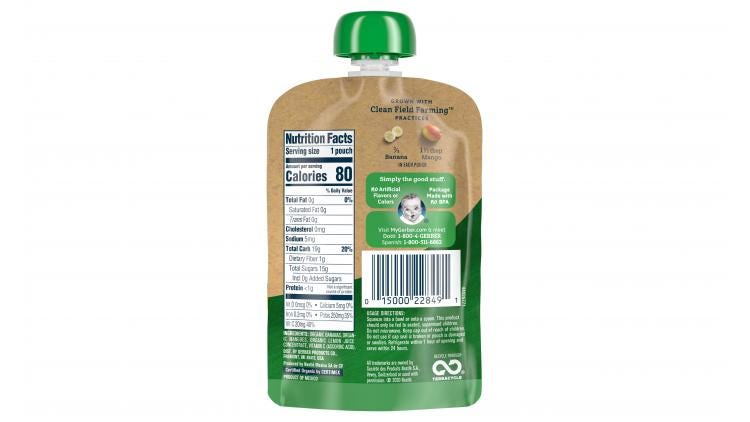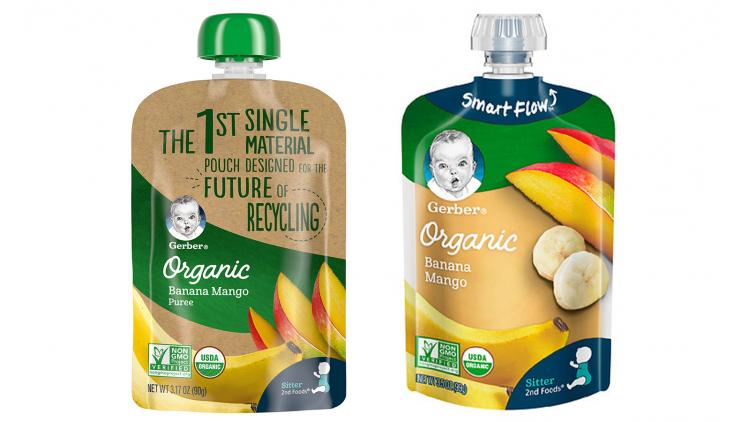May 13, 2020

Recyclable polypropylene pouch available in May that replaces an unrecyclable multilayer structure is a move toward a more circular economy.
Gerber will make available something that has not been seen before: The world’s oldest and largest baby food company will introduce in May the first single-material baby food pouch.
"Designing with a single material creates greater value for the recycling industry, promoting the development of better recycling infrastructure," says Gerber Associate Director of Packaging, Tony Dzikowicz. "After more than two years of experimenting and innovating, we were able to help create a first-of-its-kind solution for baby food that meets the safety and freshness requirements for our little ones."
With parent company Nestlé as a founding member of Materials Recovery for the Future (MRFF), a research collaborative committed to creating recycling solutions, Gerber is helping to expand curbside recycling for the pouch. MRFF's pilot program in Pottstown, PA, is the first curbside recycling program in the U.S. to accept flexible plastics such as these.
"We believe the baby food industry should help create a world where babies thrive, and initiatives like this one help us go beyond nutrition to protect the planet," said Gerber President and CEO Bill Partyka.
Dzikowicz, Gerber’s Sina Hilbert, brand manager & sustainability lead, and Justin Welke, Nestlé’s packaging project manager, respond collectively to Packaging Digest’s questions about the brand’s new recyclable flexible packaging.
Comment on Gerber’s previous pouch structure.
Gerber: Gerber launched its first baby food pouch in 2011 with a multi-material structure made from polyethylene terephthalate (PET), foil, and polyethylene (PE). In 2017, we began the transition to a non-foil multi-laminate structure to provide transparent and window options in the pouches so consumers can see the product inside.
In 2017, Gerber began conducting trials with Gualapack, the world leader of premade spouted pouches, with the goal of bringing the industry’s first mono-material pouch to market. Coming to market in May 2020, this first-of-its-kind mono-material polypropylene (PP) pouch is a step towards Gerber’s goal to make 100% of our packaging recyclable or reusable by 2025.
What’s the difference with the new recyclable pouch structure?
Gerber: The new mono-material pouch is made from polypropylene (PP), which is one of the most common and versatile forms of plastic. The current industry standard for pouches is a multi-material structure using two layers of plastic with an aluminum layer in between. This structure is not currently municipally recyclable in the U.S. due to outdated infrastructure that struggles to sort and process flexible plastics.
Moving to a mono-material structure increases the value of the recycled material for the recycling industry, promoting the development of better recycling infrastructure and encouraging a circular economy approach to plastics.
What’s the importance of curbside recyclability vs. #2 PE In-store Recycle Ready?
Gerber: We know that many parents rely on plastic — and pouches specifically — for convenience, durability and portability. However, municipal recycling infrastructure in the U.S. currently struggles to recycle most flexible packaging, including pouches.
Currently, the #2 Polyethylene (PE) in-store drop off stream is limited to plastics that are “clean and dry.” Because baby food is a wet product, it is challenging to clean and dry pouches to the level that is compatible with current store drop off programs without contaminating the waste stream.
Our new mono-material pouch is 100% recyclable through our national recycling program with TerraCycle.
The pouch is curbside recyclable for consumers in Pottstown, PA, thanks to MRFF’s pilot.

Please summarize the MRFF pilot.
Gerber: MRFF is dedicated to creating municipal recycling solutions for flexible plastic packaging such as baby food pouches, plastic shopping bags, and more. With Nestlé as a founding member, Gerber is helping to expand curbside recycling for the pouch — and all baby food pouches.
MRFF’s pilot program in Pottstown, PA, is now the first curbside recycling program in the U.S. to accept flexible plastics — including our mono-material pouch and all baby food pouches — alongside other recyclable materials. The pilot facility is aiming to recycle 6 million pounds of flexible plastic packaging annually beginning this year.
What were the packaging considerations?
Gerber: We designed the new mono-material pouch to stand out from our other products by applying a fresh design that features our key achievement, “First single-material pouch designed for the future of recycling.”
Next: Changes in Looks, Shelf Life, Size and More

New monolayer polypropylene pouch makes a bold statement in structure and with the front-panel claim.
What graphic elements are changed?
Gerber: Our number one goal was to ensure consumers understand the significance of the pouch they’re buying. Whereas the traditional pouch design featured the main ingredients (in this case mangos and bananas), the new pouch prominently features our key achievement: “The 1st single-material pouch designed for the future of recycling.”
What’s on the back panel? Are there more details about recyclability?
Gerber: Given the limited space available beyond the Nutrition Panel and other ingredient information, we chose to include the key information on the front of the pouch; however, we do include the TerraCycle logo on the back to inform consumers that these pouches are 100% recyclable through our national recycling program.
Did Gualapack supply the previous pouch?
Gerber: Gualapack has been a valued partner and one of Gerber’s main pouch suppliers since we launched our baby food pouches in 2011.
What is the pouch size or net weight, and was that changed?
Gerber: Our new mono-material pouch is the same size as our standard Organic pouch, however the fill level was slightly reduced from 99 grams/3.5 ounces to 90 grams/3.17 ounces to preserve the integrity of the mono-polypropylene structure.
Will the price stay same?
Gerber: Yes, the suggested pricing for the mono-material pouch is $1.59, which is in line with all other Gerber Organic pouches listed on TheGerberStore.com.
Is it the same shelf life?
Gerber: The shelf life of the mono-material pouch is nine months, which is a slight reduction from the 12-month shelf life of our standard Organic pouch. We’re continuing to explore ways to increase the shelf life of our mono-material pouch, while maintaining a focus on recyclability.
How did the first pouch experience help with this development?
Gerber: Since we introduced our first baby food pouch nearly 10 years ago, we’ve built substantial expertise in package development and filling operations by working with different material, designs, and equipment, as well as different partners. That expertise gave us a much stronger understanding of the performance requirements and validation needs for this first-of-its-kind pouch.
Why did the development take two years and what took the longest portion of that time?
Gerber: In developing the mono-material pouch – an industry first – we were attempting to achieve the same level of performance that is typically achieved with multiple materials. The development was an iterative process with Gualapack to address each challenge and create a market-ready product.
The initial challenges included shelf life and fragility. To solve this, we had to identify new filling parameters and barrier solutions, and work through manufacturing nuances to improve the overall quality and performance.
An additional and industry-wide challenge is creating a value stream for pouches and other flexible plastics. We have already seen early success from MRFF, and believe designing with a single material will continue to promote the development of better recycling infrastructure in the U.S.
What are the plans beyond TheGerberStore and a single SKU?
Gerber: We plan to expand our product offerings in the mono-material pouch by the end of 2020. This initial launch will give us an opportunity to gain experience in the market before expanding more broadly.
What production changes are needed?
Gerber: The mono-material pouch runs on our existing equipment, thanks to changes we made in the filling process and the pouch design itself, which was modified to improve the filling line performance.
Any advice for our readers?
Gerber: It’s imperative for all parts of an organization to work together to accomplish the goal of sustainable packaging. As the industry moves to mono-material and other designs “with the end in mind,” compromises may be required, such as shelf life, filling performance, cost of materials and more, so support from all business functions is key.
You May Also Like


